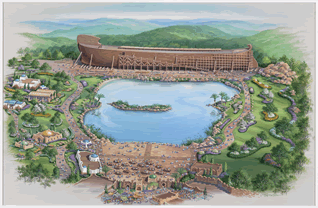Piecing Together the Ark Encounter
by Ark Encounter on December 1, 2010As the account of Noah’s Ark and the Flood continues to capture the imagination of all sectors in America, nearly every culture boasts well-known accounts of a massive flood that has elements very similar to the biblical Flood (going back even to the time of the Babylonians).
In November, 2009, a CBS News survey revealed the finding that the remains of Noah’s Ark would be the greatest archaeological discovery of our day. CBS News stated: “CBS’ 60 Minutes news program, in conjunction with Vanity Fair magazine, recently conducted a web survey asking which archaeological discovery people would most want to see made next. The response: Noah’s Ark (43%), Atlantis (18%) Amelia Earhart’s plane (16%), Nixon’s lost tapes (13%), and Cleopatra’s barge (5%).” [1]
The article continued: “Noah’s Ark continues to capture the imagination of the general public, and this interest spans all social, religious, and economic segments. The Ark and the Flood is one of the few historical events which are well known in the worldwide global circle.”
The ministry leaders at Answers in Genesis (AiG) began discussing the idea of assembling virtually the same team that designed and built the Creation Museum, to have them start researching and then building a full-scale Noah’s Ark.
Following this discussion, AiG needed to determine if there would be an audience for this type of attraction. The ministry turned once again to America’s Research Group (ARG), headed by Britt Beemer. Previously, ARG had successfully predicted first-year attendance at the Creation Museum to be around 400,000. It was a statistical bull’s-eye.
In a new national survey of individuals (whether they were religious or not), the question was asked: “If a replica of the Ark were constructed in America, would you take your family to see it?” The answer was a resounding yes—63 percent of respondents (representing 194 million Americans). ARG was then asked to give a realistic estimate of the number of people who would visit the Ark in the first year, which has been determined to be around 1.6 million individuals.
With this kind of statistical support, AiG began gathering estimates, developing funding strategies, and scouting possible land parcels in Kentucky, Ohio, and Indiana.
